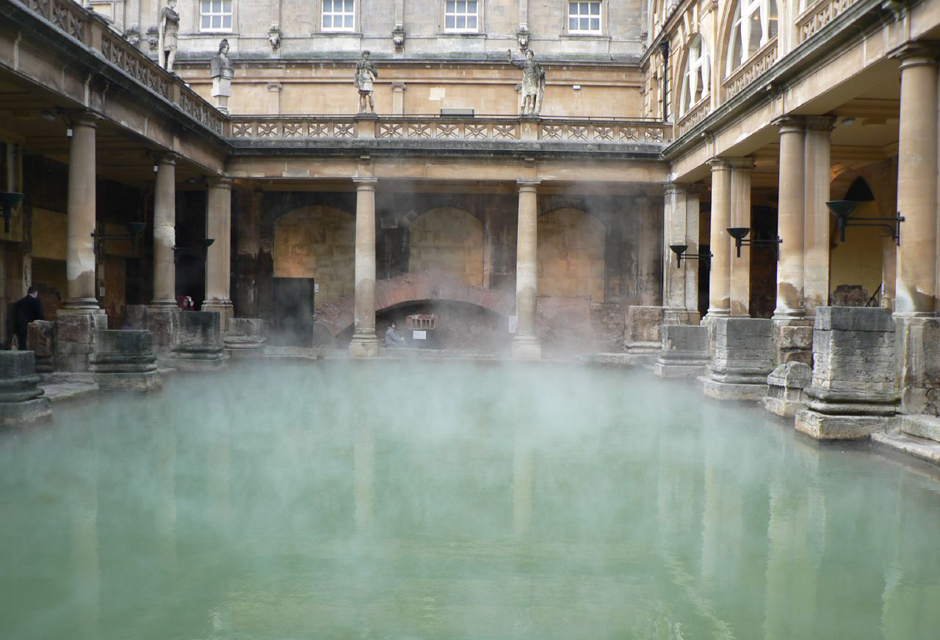
We’ll start with a simple answer.
The three letter word: ‘S’ ‘P’ ‘A’ allegedly was found scrawled on the walls of ancient Roman Baths as code in Latin for Salude Per Aqua, which can translate as “health or healing through water.”
A search of the literature reveals at least eight Latin renditions of the three-letter word: ‘S”P”A’:
- SantiPerAqua
- Sanus Per Aquam
- SaludPerAqua
- Salus Per Aquam
- Sanare Per Aquam
- Senare Per Aqua
- Santitas Per Aquas
- Solus Per Aqua
What is certain and unmistakable is that contained within all renditions of the word: ‘S’ ‘P’ ‘A’ is not only health, hygiene, and healing, but most importantly constant reference to, with, by, for and through Aqua — “The Waters.”
Other possible etymological origins exist for the Spa word that can be traced from the diminutive form of the Latin verb: spargere, to pour forth. Roman Legions built their camps and colonies at thermal springs like Baden-Baden,
Bath, Budapest, and other places where Nature’s water fountains “poured forth.”
Spa found its way into the English language through the old Wallon word ESPA meaning fountain.
In 1326 a little village located in the Ardennes Mountain in eastern Belgium attained the name Spa when hot mineral waters were rediscovered and therapeutic baths developed for their medicinal treatments.
Two-hundred and twenty-five years later, in 1551, William Slingsby discovered the sulfur springs of Tewhit at Harrogate in England. He compared these natural sulfur mineral waters to the Spa waters of Belgium and the word stuck. By the early 17th century the Doctor Dean of York published pamphlets on the waters of the English Spa W Fountain at Harrogate, and some years later, Sheridan referred to the Harrogate mineral water resort as a Spa.
And thus the idea of the modern destination Spa took hold.
But if we immerse ourselves more deeply into the ancient healing waters of Spa in search of the true spring source, we discover a steady flow of Spa Cultures and their people, places and periods that reach back decades, centuries and millennia.
A short review of the first decade of the 21st century and 20th century reveals the development and establishment of numerous national, international and global spa and wellness organizations, publications, and locations.
Similarly looking back through the periods of the 19th, 18th, 17th, and 16th centuries, through the recent millennia and even further back into the Iron, Bronze, Copper and Neolithic Ages we can read the engraved stones, parchment scrolls and written records and reports from long forgotten spa practitioners who provided places for their patients and patrons to bathe and drink, rest and relax, eat and sleep and perchance to dream…while taking the waters.
Whenever and wherever Human Culture is born, lives, and dies at some point Spa Cultures appear, blossom, ripen, and flourish…
Whenever and wherever Human Culture is born, lives, and dies at some point Spa Cultures appear, blossom, ripen, and flourish and then decline, decay, and die, only to be reborn, renewed, and relived by subsequent generations and civilizations.
These generative and regenerative archetypal processes are fundamental forms, forces, and flows within the very Nature of The Waters. Similar patterns are visible throughout the histories of human cultures as they appeared and disappeared in and around nature’s watering holes.
We moderns live surrounded and bathed in electric light speed currents of the Now; email to email, blog to blog, hour to hour, day to day…and as we grow older…month to month, year to year and decade to decade. Seldom do we take, make or even breakout of Time to reflect back and reconnect with the deeper origins of Life’s sacred sources. If and when we do, we face: “The Blood of The Earth” — nature’s living waters of health, wellness, and wholeness.
That journey can teach us much. Both inner and outer, our encounter is environmental, physical, mental, emotional and spiritual.
Jonathan Paul De Vierville
Professor Emeritus of The Humanities, History, Interdisciplinary & Global Studies at The Alamo Colleges: St. Philip’s College, San Antonio, Texas, Jonathan Paul De Vierville is also owner and director of the Alamo Plaza Spa at the historic Menger Hotel in San Antonio, Texas. His Ph.D. is from The Department of American Studies and Civilization at the University of Texas, Austin, where he wrote a two-volume dissertation: "A History of American Spas and Healing Waters." He trained at the The C. G. Jung Institute for Analytical Psychology, Zürich, Switzerland, and the Sebastian Kneipp School of Physiotherapy, Bad Wörishofen, Germany. Dr. De Vierville’s teaching and research interests are in the history of spa cultures, wellness, balneology, and natural therapeutic health care systems as well as oneirology (study of dreams), consciousness, psyche, time, sacred geometry and new cosmologies which he has taught and practiced at colleges, universities, clinics, spas and health resorts in the Americas, Europe and Asia.